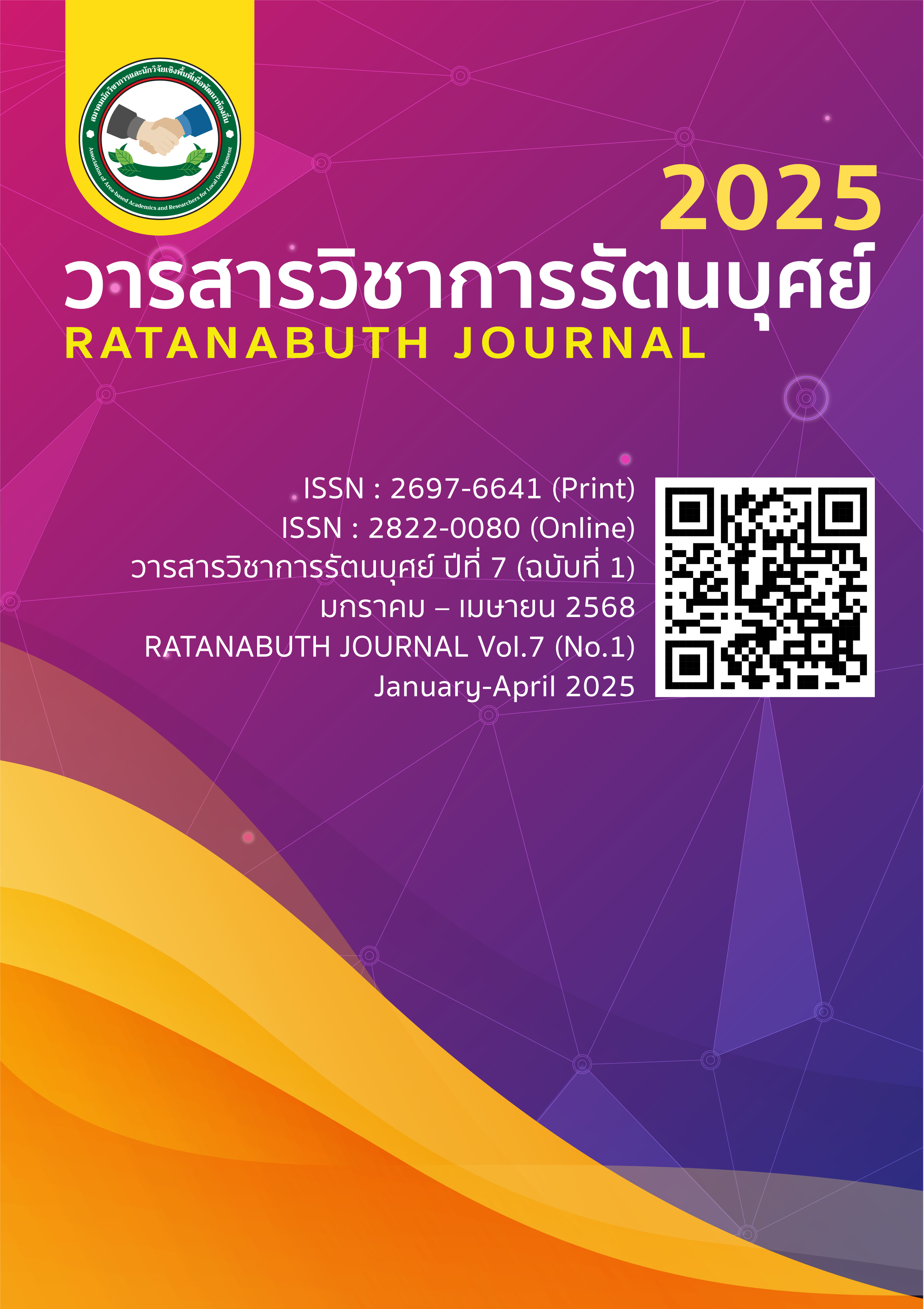A Model for Solving Thai Spelling Errors Among Fourth-Grade Students Using Word-Pattern Writing Exercises: A Case Study of Ban Samran School Samran Subdistrict Mueang District, Yasothon Province A Model for Solving Thai Spelling Errors Among Fourth-Grade Students Using Word-Pattern Writing Exercises: A Case Study of Ban Samran School Samran Subdistrict Mueang District, Yasothon Province
Main Article Content
Abstract
The objective of this research was to develop a remedial model for improving Thai word spelling among Grade 4 students through the use of spelling practice exercises based on Thai orthographic rules. The study was conducted as a case study at Ban Samran School, Samran Sub-district, Mueang District, Yasothon Province. A quasi-experimental research design was employed, with the sample divided into two groups: an experimental group (n = 7), which received instruction using the developed spelling exercises, and a control group (n = 7), which received conventional instruction. The research instruments included a set of spelling exercises, pre- and post-tests, and a student attitude questionnaire toward spelling instruction. Data were analyzed using mean scores, standard deviation, and the E1/E2 efficiency index.
The findings revealed that the students in the experimental group demonstrated statistically significant improvement in their spelling accuracy at the .05 level compared to the control group. The efficiency values of the developed instructional set were E1 = 82.34 and E2 = 84.50. Moreover, students in the experimental group exhibited more positive attitudes toward spelling instruction, showing greater interest and enthusiasm in practice. These results suggest that the developed spelling exercises are an effective supplementary tool for enhancing Thai writing skills among primary school students and can be adapted for use in other Thai language teaching contexts.
Article Details

This work is licensed under a Creative Commons Attribution-NonCommercial-NoDerivatives 4.0 International License.
References
กรรณิการ พวงเกษม. (2534). ปัญหาและกลวิธีการสอนภาษาไทยในโรงเรียนประถมศึกษา (พิมพ์ครั้งที่ 2). กรุงเทพฯ: โรงพิมพ์วัฒนาพานิช.
จิตรา สมพล. (2547). การพัฒนาแบบฝึกทักษะการเขียนสะกดคำ วิชาภาษาไทยชั้นประถมศึกษาปีที่ 6.วิทยานิพนธ์ครุศาสตรมหาบัณฑิต. อุบลราชธานี: มหาวิทยาลัยราชภัฏอุบลราชธานี.
ชุติมา ธีรชัย. (2561). บทบาทของแบบฝึกหัดในการพัฒนาทักษะการเขียนของนักเรียนประถมศึกษา. ขอนแก่น: มหาวิทยาลัยขอนแก่น.
ณัฐญา เมืองสุข, & ศิริพร พึ่งเพ็ชร์. (2567). การพัฒนาความสามารถการอ่าน การเขียนสะกดคำภาษาไทยของนักเรียนชั้นประถมศึกษาปีที่ 3 โดยการจัดการเรียนรู้ตามรูปแบบของฮันเตอร์ร่วมกับแบบฝึกทักษะ. Journal of MCU Ubon Review, 9(3), 447–456.
ธรรศพร เคยชิน, วิภาษณ์ เทศน์ธรรม, & พีรพงษ์ แสนสิ่ง. (2567). การพัฒนาทักษะการเขียนภาษาไทยโดยใช้ชุดแบบฝึกทักษะการเขียนภาษาไทยของนักเรียนชั้นปีที่ 3 โรงเรียนบ้านนาสะไมย์ ตำบลนาสะไมย์ อำเภอเมือง จังหวัดยโสธร. Journal of MBU Yotsunthon Review, 1(2), 29–43.
ธิดารัตน์ จูมพลา. (2546). การพัฒนาความพร้อมของนักเรียนชั้นอนุบาลปีที่ 2 โดยใช้แบบฝึกความพร้อมด้านสติปัญญา.ปริญญานิพนธ์การศึกษามหาบัณฑิต. มหาสารคาม: มหาวิทยาลัยมหาสารคาม.
ธีรวุฒิ เอกะกุล. (2543). ระเบียบวิธีวิจัยทางพฤติกรรมศาสตร์และสังคมศาสตร์. อุบลราชธานี: สถาบันราชภัฏอุบลราชธานี.
นิลาภรณ์ ธรรมวิเศษ. (2546). การพัฒนาแบบฝึกทักษะการเขียนสะกดคำในมาตราแม่กดสำหรับนักเรียนชั้นประถมศึกษาปีที่ 4 .วิทยานิพนธ์ครุศาสตรมหาบัณฑิต. อุบลราชธานี: มหาวิทยาลัยราชภัฏอุบลราชธานี.
เบญจพร สร้อยสิริสุนทร, & อรนุช ลิมตศิริ. (2567). การเปรียบเทียบผลสัมฤทธิ์ทางการเรียนวิชาภาษาไทยเรื่องคำที่มาจากภาษาต่างประเทศของนักเรียนชั้นมัธยมศึกษาปีที่ 3 ที่ได้รับการสอนโดยใช้สื่อประสมและการสอนตามปกติ. Journal of Buddhist Education and Research, 11(2), 175–183.
พรกนก สุวรรณรัตน์, พัชยากรณ์ พูลเกตุ, & โสภณ ชัยวัฒนกุลวานิช. (2567). การพัฒนาทักษะการเขียนคำพื้นฐานภาษาไทย หมวดสัตว์ โดยใช้แบบฝึกทักษะการเขียนสำหรับนักเรียนที่มีความบกพร่องทางการได้ยิน. วารสารราชภัฏเพชรบูรณ์สาร, 26(2), 113–121.
ภูริตา สมาธิฤาทัย, สนิท สัตโยภาส, & ศศิธร อินตุ่น. (2567). การสร้างหนังสือเสริมประสบการณ์พัฒนาผลสัมฤทธิ์การเขียนสะกดคำเรื่องสระในภาษาไทยสำหรับนักเรียนชั้นประถมศึกษาปีที่ 1. Journal of MCU Ubon Review, 9(3), 474–486.
มนทิรา ภักดีณรงค์. (2541). การศึกษาแบบฝึกกิจกรรมขั้นที่ 5 ที่มีประสิทธิภาพและความคงทนในการเรียนรู้เรื่องยังไม่สายเกินไป วิชาภาษาไทย ชั้นประถมศึกษาปีที่ 2 โดยการสอนแบบมุ่งประสบการณ์ภาษา.วิทยานิพนธ์การศึกษามหาบัณฑิต. มหาสารคาม: มหาวิทยาลัยมหาสารคาม.
วจนะ พรสีเกาะ, ธัญญลักษณ์ เขจรภักดิ์, & สมาน เอกพิมพ์. (2567). การพัฒนาความสามารถการอ่านและการเขียนแจกลูกสะกดคำภาษาไทยโดยการจัดการเรียนรู้แบบ PWIM ของนักเรียนชั้นประถมศึกษาปีที่ 1. วารสารบัณฑิตศาส์น มหาวิทยาลัยมหามกุฏราชวิทยาลัย, 22(2), 156–167.
วรรณา แซ่ตั้ง. (2541). การสร้างแบบฝึกหัดการเขียนสะกดคำของนักเรียนชั้นประถมศึกษาปีที่ 1.ปริญญานิพนธ์การศึกษามหาบัณฑิต. กรุงเทพฯ: มหาวิทยาลัยศรีนครินทรวิโรฒประสานมิตร.
วิมลรัตน์ สุนทรโรจน์. (2549). เอกสารประกอบการสอนวิชา 0506703 การพัฒนาการเรียนการสอน. มหาสารคาม: คณะศึกษาศาสตร์ มหาวิทยาลัยมหาสารคาม.
เสาวพา บัวขนาบ, & กรวิภา สรรพกิจจำนง. (2567). การเปรียบเทียบผลสัมฤทธิ์ทางการเรียนวิชาภาษาไทยเรื่องสระเปลี่ยนรูปและสระลดรูปของนักเรียนชั้นประถมศึกษาปีที่ 1 ระหว่างการสอนโดยใช้หนังสือส่งเสริมการอ่านเพิ่มเติมชุดหนูดีชวนอ่านสระกับการสอนแบบปกติ. วารสารวิชาการและวิจัย มหาวิทยาลัยภาคตะวันออกเฉียงเหนือ, 14(1), 194–206.
อรพินท์ ไชยยศ. (2562). การสะกดคำของนักเรียนประถมศึกษา. กรุงเทพฯ: มหาวิทยาลัยธรรมศาสตร์.
Byrne, B. (2005). Theories of learning and the development of literacy skills. Cambridge: Cambridge University Press.
Rovinelli, R. J., & Hambleton, R. K. (1977). On the use of content specialists in the assessment of criterion-referenced test item validity. Tijdschrift voor Onderwijs research, 2(2), 49–60.
Snowling, M., & Hulme, C. (2011). Children’s reading and spelling development. Oxford: Wiley-Blackwell.
Treiman, R. (1993). Beginning to spell: A study of first-grade children. New York: Oxford University Press.

